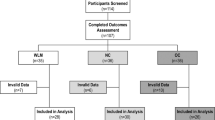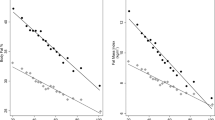Abstract
OBJECTIVE: To compare the frequency and duration of varying intensities of physical activity performed by adults trying to lose weight, avoid gaining weight and not actively trying to control their weight, and to compare these groups' beliefs about the physical activity they should perform.
METHOD: Random postal survey of 2500 Victorian adults selected from the Australian electoral roll (response rate=42%).
MEASURES: One-week physical activity recall (frequency and duration of walking, other moderate activity and vigorous activity), BMI (based on self-reported height and weight) and weight-control behaviour.
RESULTS: At the time of the survey, 27% of respondents were actively trying to avoid gaining weight, 23.9% trying to lose weight and 49.1% undertaking no weight control. Respondents spent a mean time of 4.0 (±7.1) h walking, 5.5 (±7.9) h in moderate activity and 3.1(±5.9) h in vigorous activity during the week prior to the survey. Women trying to lose weight or avoid gaining weight engaged in vigorous activity more often than women not trying to control their weight. After adjusting for age, education and BMI, women trying to avoid gaining weight were 2.4 times more likely, and women trying to lose weight 2.5 times more likely, to have met current physical activity guidelines than women undertaking no weight control. On average, respondents believed they should spend 5.2 (±6.9) h walking, 6.5 (±8.2) h in moderate activity and 4.3 (±6.5) h in vigorous activity each week. Women trying to lose weight felt they should perform vigorous activity more often than other women. Weight-control behaviour was not associated with physical activity beliefs and behaviours of men.
CONCLUSION: Walking is a common activity among adults attempting weight control. However, many men and women do not fully recognize the value of moderate-intensity physical activity. Future efforts should be directed at promoting the role of moderate-intensity activity in weight control, particularly activity that can be performed outside of planned activity sessions.
This is a preview of subscription content, access via your institution
Access options
Subscribe to this journal
Receive 12 print issues and online access
$259.00 per year
only $21.58 per issue
Buy this article
- Purchase on Springer Link
- Instant access to full article PDF
Prices may be subject to local taxes which are calculated during checkout


Similar content being viewed by others
References
World Health Organisation . Obesity, preventing and managing the global epidemic: Report of the WHO consultation on obesity. World Health Organisation: Geneva 1997.
Garrow JS, Summerbell CD . Meta-analysis: Effect of exercise, with or without dieting, on the body composition of overweight subjects Eur J Clin Nutr 1995 49: 1–10.
Grilo CM . The role of physical activity in weight loss and weight loss management Med Exerc Nutr Health 1995 4: 60–76.
Hill JO, Schlundt DG, Sbrocco T, Sharp T, Pope-Cordie J, Stetson B, Kaler M, Heim C . Evaluation of an alternating-calorie diet with or without exercise in the treatment of obesity Am J Clin Nutr 1989 50: 248–254.
Pavlou KN, Krey S, Steffee WP . Exercise as an adjunct to weight loss and maintenance in moderately obese subjects Am J Clin Nutr 1989 49: 1115–1123.
Saris WHM . Fit, fat and fat free: The metabolic aspects of weight control Int J Obes 1998 22: S15–S21.
US Department of Health and Human Services . Physical activity and health: A report of the Surgeon General. Department of Health and Human Services, Centers for Disease Control and Prevention, National Center for Chronic Disease Prevention and Health Promotion: Atlanta, GA 1996.
Dunn AL, Anderson RE, Jakicic JM . Lifestyle physical activity interventions: history, short- and long-term effects, and recommendations Am J Prevent Med 1998 15: 398–412.
Pate RR, Pratt M, Blair SN, Haskell WL, Macera CA, Bouchard C, Buchner D, Ettinger W, Heath GW, King AC, Kriska A, Leon AS, Marcus BH, Morris J, Paffenbarger RS, Patrick K, Pollock ML, Rippe JM, Sallis J, Wilmore JH . Physical activity and public health: A recommendation from the Centers for Disease Control and Prevention and the American College of Sports Medicine JAMA 1995 273: 402–407.
Crawford D, Owen N, Broom D, Worcester M, Oliver G . Weight-control practices of adults in a rural community Aust NZ J Public Health 1998 22: 73–79.
Levy AS, Heaton AW . Weight control practices of US adults trying to lose weight Ann Intern Med 1993 199: 661–666.
Serdula MK, Williamson DF, Anda RF, Levy A, Heaton A, Byers T . Weight control practices in adults: Results of a multistate telephone survey Am J Public Health 1994 84: 1821–1824.
DiPietro L, Williamson DF, Casperson CJ, Eaker E . The descriptive epidemiology of selected physical activities and body weight among adults trying to lose weight: The Behavioral Risk Factor Surveillance System survey, 1989 Int J Obes 1993 17: 69–76.
Australian Bureau of Statistics . ASCO—Australian standard classification of occupations. Catalogue no. 1221.0. Australian Government Publishing Service: Canberra 1994.
Waters AM . Assessment of self-reported height and weight and their use in the determination of Body Mass Index. Australian Institute of Health and Welfare: Canberra 1993.
National Health and Medical Research Council . Acting on Australia's weight: A strategy for the prevention of overweight and obesity. Australian Government Publishing Service: Canberra 1997.
Smith JR, Owen N, Leslie E, Bauman A . Active for life: Physical activity patterns and health impacts in Victoria 1998. Victorian Department of Human Services: Melbourne 1999.
Booth ML, Owen N, Bauman A, Gore CJ . Retest reliability of recall measures of leisure-time physical activity in Australian adults Int J Epidemiol 1996 25: 153–159.
Booth ML, Owen N, Bauman A, Gore CJ . Relationship between a fourteen-day recall measure of leisure-time physical activity and a sub-maximal test of physical work capacity in a population sample of Australian adults Res Q Exer Sport 1996 67: 221–227.
Ainsworth BE, Haskell WL, Leon AS, Jacobs DR, Montoye HJ, Sallis JF, Paffenbarger, RS . Compendium of physical activities: Classification of energy costs of human physical activities Med Sci Sport Exer 1993 25: 71–80.
SPSS 8.0 for Windows, Release 8.0. SPSS Inc.: Chicago, IL 1997.
Australian Bureau of Statistics . Census of population and housing: Selected social and housing characteristics for statistical local areas, Victoria 1996. Catalogue no. 2015.2. Australian Government Publishing Service: Canberra 1996.
Australian Bureau of Statistics . Labour force, Victoria 1996. Catalogue no. 6202.2. Australian Government Publishing Service: Canberra 1996.
Australian Bureau of Statistics . National Health Survey: Summary results, Australian states and territories. Catalogue no. 4368.0. Australian Government Publishing Service: Canberra 1997.
Morris JN, Hardman AE . Walking to health Sports Med 1997 23: 306–322.
Egger G, Mowbray G . A qualitative analysis of obesity and at-risk overweight in working men Aust J Nutr Diet 1993 50: 10–14.
Booth ML, Bauman A, Owen N, Gore CJ . Physical activity preferences, preferred sources of assistance, and perceived barriers to increased activity among physically inactive Australians Prev Med 1997 26: 131–137.
Johnson CA, Corrigan SA, Dubbert PM, Grambling SE . Perceived barriers to exercise and weight control practices in community women Women's Health 1990 16: 177–191.
Author information
Authors and Affiliations
Corresponding author
Rights and permissions
About this article
Cite this article
Timperio, A., Cameron-Smith, D., Burns, C. et al. Physical activity beliefs and behaviours among adults attempting weight control. Int J Obes 24, 81–87 (2000). https://doi.org/10.1038/sj.ijo.0801089
Received:
Revised:
Accepted:
Published:
Issue Date:
DOI: https://doi.org/10.1038/sj.ijo.0801089



